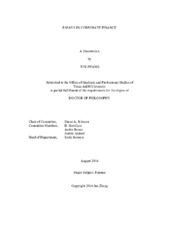| dc.description.abstract | The first essay, “Local Institutional Investors and the Maturity Structure of Corporate Debt”, examines the relation between the geographic proximity of a firm’s institutional shareholders and its debt maturity choices. Local institutional investors may pressure firms to employ short-term debt as a means of disciplining managers to reduce equity agency costs, and to reduce debt agency costs associated with debtholder-stockholder conflicts caused by monitoring of local institutional investors. Thus, we hypothesize that firms with local institutional investors choose shorter debt maturity
structures. Using dynamic GMM estimators to account for endogeneity and dynamic relations between debt maturity structure and institutional proximity, we find that firms with local institutional investors have shorter maturity debt. Similar results obtain for the maturity of new debt issues. To help establish causality, we use Sarbanes-Oxley Act as a quasi-natural experiment, conduct a nearest neighbor matching analysis that holds location constant, and employ a sample of firms’ headquarter relocations as quasi-exogenous shocks to the locality of institutional investors. The results demonstrate the importance of local institutional investors in affecting firms’ debt maturity policy choices.
In the second essay, “The Effect of Algorithmic Trading on Firm Value”, we study the overall impact of algorithmic trading on firm value. Extant literature has found mixed evidence on the impact of algorithmic trading on market quality, and it is still under intense public debate and controversy that whether algorithmic trading is beneficial or not. Using an algorithmic trading proxy based on electronic message traffic, we find a positive relation between algorithmic trading and firm value. The relation is stronger for firms with lower stock liquidity, higher idiosyncratic volatility, higher analyst coverage, and greater information asymmetry, which suggest that the value increases occur through market quality channels. The results are robust to various model specifications, reverse causality test using NYSE automated quote dissemination as an exogenous shock, and endogeneity concerns. The results imply net benefits of algorithmic trading to firms. | en |


